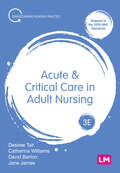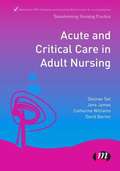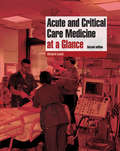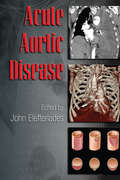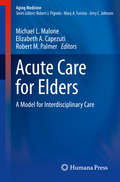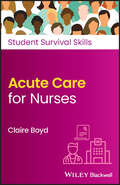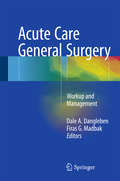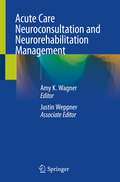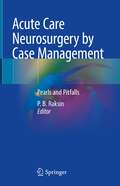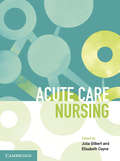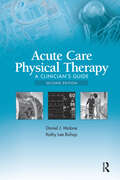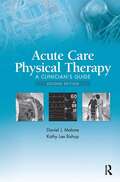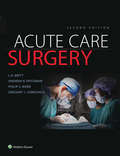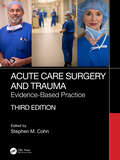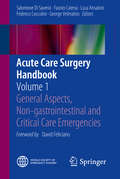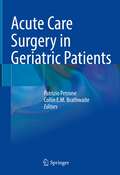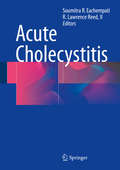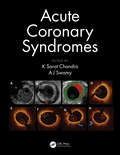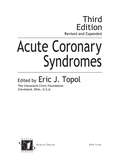- Table View
- List View
Acute and Critical Care in Adult Nursing (Transforming Nursing Practice Series)
by Desiree Tait Catherine Williams Dave Barton Jane JamesThis book helps adult nursing students to competently manage care of critically and acutely ill patients, and to recognise and deal with the early signs of deterioration. The book takes a practical real-life approach to care, with each chapter focusing on patients with specific problems, then interweaving the knowledge and skills needed to care for that patient. The book focuses on developing clinical assessment and decision-making skills so that students are able to care for patients who are unstable, deteriorating or critically ill, regardless of their location.
Acute and Critical Care in Adult Nursing
by Catherine Williams Desiree Tait Dr Dave Barton Jane JamesThe assessment and management of patients who are critically or acutely ill, or showing signs of clinical deterioration, is a crucial nursing skill. This book will help adult nursing students to competently manage care of critically and acutely ill patients, and to recognise and deal with the early signs of deterioration. The book takes a practical real-life approach to care, with each chapter focussing on patients with specific problems, then interweaving the knowledge and skills needed to care for that patient, including the nurse's role and responsibilities, assessment, diagnosis, planning, management, related pathophysiology and collaborative team working.
Acute and Critical Care Medicine at a Glance (At a Glance)
by Richard M. LeachThe at a Glance series is popular among medical students and junior doctors for its concise and simple approach and excellent illustrations. Each bite-sized chapter is covered in a double-page spread with colour summary diagrams on the left page and explanatory text on the right. Covering a wide range of topics, books in the at a Glance series are ideal as introductory subject texts or for revision purposes, and are useful throughout medical school and beyond. Everything you need to know about Acute and Critical Care Medicine...at a Glance! Following the familiar, easy-to-use at a Glance format, and now in full-colour, Acute and Critical Care Medicine at a Glance is an accessible introduction and revision text for medical students. Fully revised and updated to reflect changes to the content and assessment methods used by medical schools, this at a Glance provides a user-friendly overview of Acute and Critical Care Medicine to encapsulate all that the student needs to know. This new edition of Acute and Critical Care Medicine at a Glance: Provides a brief and straightforward, yet rapid, introduction to care of the critically ill that can be easily assimilated prior to starting a new job or clinical attachment Encompasses the clinical, diagnostic and therapeutic skills required to manage acutely ill patients in a variety of settings Includes assessment of the acutely unwell patient, monitoring, emergency resuscitation, oxygenation, circulatory support, methods of ventilation and management of a wide variety of medical and surgical emergencies Includes new chapters on fluid management, oxygenation, non-invasive ventilation, recognition of the seriously ill patient and hospital-acquired infections This book is an invaluable resource for all undergraduates in medicine, as well as clinical medical students, junior doctors, nurses caring for acutely-ill patients and paramedics. Pre-publication reviews: "The material forms an excellent basis for junior doctors in critical care and anaesthesia to get a good grounding in the subject, without appearing too scary." –Senior House Officer "The system-based approach...provides excellent reference material when studying a particular subject, allowing the reader to easily delve into the book when necessary, without having to read from cover-to-cover. It is an excellent revision aid.... Much time has gone into eliminating superfluous data so maximal essential information can be conveyed quickly." –UCL student
Acute and Critical Care Medicine at a Glance
by Richard M. LeachThe at a Glance series is popular among medical students and junior doctors for its concise and simple approach and excellent illustrations.Each bite-sized chapter is covered in a double-page spread with colour summary diagrams on the left page and explanatory text on the right. Covering a wide range of topics, books in the at a Glance series are ideal as introductory subject texts or for revision purposes, and are useful throughout medical school and beyond.Everything you need to know about Acute and Critical Care Medicine...at a Glance!Following the familiar, easy-to-use at a Glance format, and now in full-colour, Acute and Critical Care Medicine at a Glance is an accessible introduction and revision text for medical students. Fully revised and updated to reflect changes to the content and assessment methods used by medical schools, this at a Glance provides a user-friendly overview of Acute and Critical Care Medicine to encapsulate all that the student needs to know.This new edition of Acute and Critical Care Medicine at a Glance:Provides a brief and straightforward, yet rapid, introduction to care of the critically ill that can be easily assimilated prior to starting a new job or clinical attachmentEncompasses the clinical, diagnostic and therapeutic skills required to manage acutely ill patients in a variety of settingsIncludes assessment of the acutely unwell patient, monitoring, emergency resuscitation, oxygenation, circulatory support, methods of ventilation and management of a wide variety of medical and surgical emergenciesIncludes new chapters on fluid management, oxygenation, non-invasive ventilation, recognition of the seriously ill patient and hospital-acquired infectionsThis book is an invaluable resource for all undergraduates in medicine, as well as clinical medical students, junior doctors, nurses caring for acutely-ill patients and paramedics.Pre-publication reviews:"The material forms an excellent basis for junior doctors in critical care and anaesthesia to get a good grounding in the subject, without appearing too scary."-Senior House Officer"The system-based approach...provides excellent reference material when studying a particular subject, allowing the reader to easily delve into the book when necessary, without having to read from cover-to-cover. It is an excellent revision aid.... Much time has gone into eliminating superfluous data so maximal essential information can be conveyed quickly."-UCL student
Acute and Critical Care Nursing at a Glance
by Helen Dutton Jacqui FinchFrom the publishers of the market-leading at a Glance series comes a comprehensive yet accessible overview of all the fundamental elements of acute and critical care nursing. <p><p> Acute and Critical Care Nursing at a Glance provides an introduction to the key knowledge and skills for patient assessment and problem identification, as well as how to plan, implement and evaluate care management strategies. It also explores clinical decision-making processes and their impact on care delivery, as well as key psychosocial issues, pain management, and safe transfer. All information is presented in a clear, double-page spread with key information accompanied by tables, illustrations, photographs and diagrams.
Acute Aortic Disease (Fundamental and Clinical Cardiology)
by John A. ElefteriadesCovering the pathophysiology, imaging, diagnosis, and treatment of a variety of aortic aneurysms and dissections, this source helps physicians effectively examine and evaluate affected individuals in clinical or emergency care settings. Offering a wide array of illustrations, x-rays, and operative photographs to emphasize key anatomic observations,
Acute Care and Emergency Gynecology
by David Chelmow Christine R. Isaacs Ashley Carroll David Chelmow Christine R. IsaacsAcute Care and Emergency Gynecology covers almost 100 common and uncommon gynecologic problems encountered in urgent and emergency settings. Problems are presented in a case-based approach, integrating relevant evidence-based major Society recommendations where available, and supplementing with carefully researched expert opinion for many common situations for which no guidelines apply. The emphasis in on management. Discussions are designed to be detailed enough to guide practice, but focused to where they can be read in the time available prior to seeing a patient. The book serves two goals: first, it is designed for the many providers who prefer case-based learning, particularly for continuing professional development purposes; secondly, it is designed for rapid reference for someone seeing a similar case in this setting. Essential reading for physicians, midwives, nurse practitioners, and physician assistants in the areas of gynecology, family medicine, and primary care who provide gynecologic care in the urgent and emergency setting.
Acute Care for Elders: A Model for Interdisciplinary Care (Aging Medicine)
by Michael L. Malone Elizabeth A. Capezuti Robert M. PalmerAcute Care for Elders (ACE) is a model of care designed to improve functional outcomes and to improve the processes for the care of older patients. This model includes: an environment of care designed to promote improved function for older patients; an interdisciplinary team that works together to identify/address the vulnerabilities of the older patients; nursing care plans for prevention of disability; early planning to help prepare the patient to return home and a review of medical care to prevent iatrogenic illness. Acute Care for Elders: A Model for Interdisciplinary Care is an essential new resource aimed at assisting providers in developing and sustaining an ACE program The interdisciplinary approach provides an introduction to the key vulnerabilities of older adults and defines the lessons learned from the Acute Care for Elders model Expertly written chapters describe critical aspects of ACE: the interdisciplinary approach and the focus on function The fundamental principles of ACE described in this book will further assist hospital leaders to develop, implement, sustain and disseminate the Acute Care for Elders model of care. Acute Care for Elders: A Model for Interdisciplinary Care is of great value to geriatricians, hospitalists, advance practice nurses, social workers and all others who provide high quality care to older patients.
Acute Care for Nurses (Student Survival Skills)
by Claire BoydAcute Care for Nurses A practical handbook to boost your confidence with assessment techniques and key clinical skills when administering effective acute care This helpful revision tool was developed to assist healthcare workers in the field of acute care, at a time when healthcare professionals have been under more pressure than ever before. In Acute Care for Nurses, readers will find: A revision of medicines management formulas, plus advanced formulas seen in a clinical setting, with chapters on sepsis and conflict resolution Assessment techniques and the individual components of the ABCDE assessment, covering vital signs, clinical observation at superficial and more in-depth levels, and clinical actions Higher skills, such as caring for the ventilated patient and fluid resuscitation in adults and children, and subcutaneous fluid hydration Critical care simulation and need-to-know medical abbreviations, plus three helpful appendices containing tool kits and charts Acute Care for Nurses is a must-have resource for nursing students, including nursing associates, registered nurses and midwives, assistant practitioners and senior healthcare assistants, return to practice nurses, overseas nurses and anyone else requiring acute clinical skills and assessment techniques.
Acute Care General Surgery: Workup and Management
by Firas G. Madbak Dale A. DanglebenAcute Care General Surgery provides a succinct focused overview of a myriad of general surgical emergencies. Each chapter has a concise, practical framework on the workup and management of a specific topic. The book covers a wide array of pathology from the more common appendicitis, diverticulitis and cholecystitis to those less frequently encountered such as toxic megacolon, Fournier's gangrene and volvulus. Learning objectives for each chapter are clearly defined. In addition to differential diagnosis, the work up and management is comprehensively discussed. In addition, a pithy clinical pearl is included to serve as a memory aid for each diagnosis. Upon reviewing this volume, clinicians who encounter the acute care surgical patient in their practices will be better equipped to rapidly assess, evaluate, diagnose and managing their complex and often challenging problems.
Acute Care Neuroconsultation and Neurorehabilitation Management
by Amy K. Wagner Justin WeppnerThis book is a comprehensive resource on acute neurorehabilitation consultations. When a patient first undergoes a traumatic brain or acquired spinal cord injury, an immediate consultation is needed with a rehabilitation specialist. In-depth literature reviews, practice guidelines, and case studies offer in-depth, practical coverage of the complete neurorehabilitation consultation with information on specific testing tools and metrics. The acute care consultant works in concert with other physicians and medical professionals, so throughout the text considerations on how to best organize the team to maximize care is carefully considered. Chapters also explore acute neurological sequelae, including arousal and stimulation, sleep, agitation, spasticity, and seizure prevention, for which an acute care consultant could provide important insight, treatment, and future management recommendations. The book concludes with advice on how to best transition patients from acute to long-term care, including patient prognostication and family education. This is an ideal guide for physiatrists and neurologists aiming to maximize recovery outcomes for their patients.
Acute Care Neurosurgery by Case Management: Pearls and Pitfalls
by P. B. RaksinThis book reviews the common clinical scenarios that might trigger emergent consultation for neurosurgical intervention, with attention to key components of the clinical interview and exam, optimal diagnostic evaluation, indications for and the goals of operative intervention, perioperative considerations, and strategies for complication mitigation. This is not a surgical atlas, but rather, a road map for the journey to the operating room door. The intent is to establish a systematic, evidence-based action plan for the patient presenting in neurologic crisis. Each chapter opens with a relevant case vignette and then unfolds through uniform sections to tell the story of how one might approach the disease entity in question, from initial request for consultation to definitive management, highlighting steps of the decision-making process: • What are the highest yield questions to ask during a focused interview? • What are the most pertinent objective exam findings? • What is the proper differential diagnosis? • What is the most appropriate and efficient plan for diagnostic evaluation – with respect to laboratories and imaging? • Does this patient have an indication for emergent or urgent neurosurgical intervention? • If so, what is the goal of that intervention? • What are the most common potential complications of the proposed procedure, and what steps might be taken to mitigate those risks? Each chapter is punctuated by 3-5 teaching pearls, summarizing these key elements. The overall goal is to create a framework for assessment that might be applied in the emergency department, the trauma bay, or the ICU when a neurologic emergency arises. The scope of the text encompasses not only cranial and spinal trauma, but also entities such as shunt failure, stroke, aneurysmal subarachnoid hemorrhage, pituitary apoplexy, cauda equina syndrome, and central nervous system infection that might require time-sensitive intervention. An additional section addresses issues requiring emergent neurosurgical response in the ICU setting, including sudden neurologic worsening, status epilepticus, and abnormal clotting/ coagulopathy. The text will not only serve as a valuable resource for those preparing to take the oral board exam, but will also provide a targeted refresher for clinicians taking general neurosurgical call in the community as well as an educational reference for mid-level practitioners and those in training who are serving as first responders on behalf of a neurosurgical service.
The Acute-Care Nurse Practitioner: A Transformational Journey
by Judy RashotteFrom the moment it was first proposed, the role of the nurse practitioner has been steeped in controversy. In the fields of both nursing and medicine, the idea that a nurse practitioner can, to some degree, serve as a replacement for the physician has sparked heated debates. Perhaps for that reason, despite the progress of the nurse practitioner movement, NPs have been reluctant to speak about themselves and their work, and their own vision of their role has thus remained largely invisible. Current research is dominated by instrumental and economic modes of discourse and tends to focus on the clinical activities associated with the role. Although information about demographics, educational preparation, position titles, reporting relationships, and costs of care contribute to our understanding, what was missing was an exploration of the lived experience of the nurse practitioner, as a means to deepen that understanding as well as our appreciation for their role. The Acute-Care Nurse Practitioner is based on in-depth interviews with twenty-six nurse practitioners working in acute-care settings within tertiary-care institutions all across Canada. Employing a hermeneutic approach, Rashotte explores the perspectives from which NPs view their reality as they undergo a transformational journey of becoming—a journey that is directed both outward, into the world, and inward, into the self. We learn how, in their struggle to engage in a meaningful practice that fulfills their goals as nurses, their purpose was hindered or achieved. In large part, the story unfolds in the voices of the NPs themselves, but their words are complemented by descriptive passages and excerpts of poetry that construct an animated and powerful commentary on their journey. Poised between two worlds, NPs make a significant contribution to the work of their colleagues and to the care of patients and families. The Acute-Care Nurse Practitioner offers an experiential alternative to conventional discourse surrounding this health care provider’s role.
Acute Care Nursing
by Julia Gilbert Elisabeth CoyneAcute Care Nursing provides an accessible and practical overview of the role of the nurse in acute medical and surgical settings in the Australian and New Zealand context. Linking closely with the Australian 'Registered nurse standards for practice' and the New Zealand Competencies for Registered Nurses, this text equips students with foundational knowledge of the pathophysiology, treatment and legal and ethical issues associated with common acute conditions. Through the person-centred, collaborative care approach, students will also learn effective communication, decision-making and cultural competency skills that are essential for nurses in any practice context. Each chapter is enriched with pedagogical features designed to solidify understanding and promote critical thinking, including case studies, reflections, key terms, review questions, research topics and further readings. Offering students a relevant and contemporary understanding of the acute care context, Acute Care Nursing is an essential companion that can be taken from the classroom into practice.
Acute Care of the Cancer Patient
by Andrew D. Shaw Bernhard J. Riedel Allen W. Burton Alan I. Fields Thomas W. FeeleyDrawing on the real-world experience of leading experts in oncological medicine, this reference serves as an invaluable source of guidance for anyone specializing in the care of acutely ill cancer patients-providing quick reference to effective techniques, therapies, and approaches for surgical, medical, pediatric, pain, and general oncology issues
Acute Care Physical Therapy: A Clinician’s Guide
by Daniel J. Malone Kathy Lee BishopAcutely ill patients are found in the hospital, in the skilled nursing facility, in inpatient rehabilitation facilities, in outpatient practices, and in the home. The role of the physical therapist and physical therapist assistant is to rehabilitate these vulnerable and frail patients to enhance their health and functioning. The goal of Acute Care Physical Therapy: A Clinician’s Guide, Second Edition is to provide the acute care practitioner with the necessary knowledge to improve patients’ structural impairments and activity limitations so they can more successfully participate in life. Nothing could be more challenging and rewarding. Inside, Drs. Daniel Malone and Kathy Lee Bishop, along with their contributors, provide a comprehensive review of acute care physical therapist best practice. This text builds upon fundamental knowledge by addressing important components of the patient examination ranging from the patient’s medical history to laboratory testing to life supporting equipment. Following this introduction, each chapter highlights specific organ systems with a review of pertinent anatomy and physiology followed by common health conditions and medical management. Important physical therapy concerns, examination findings, and rehabilitation interventions are discussed in detail. This Second Edition includes numerous tables, figures, review questions, and case studies that highlight clinical reasoning and the physical therapy patient care model as outlined in the Guide to Physical Therapist Practice. New in the Second Edition: Increased focus on evidence-based examination, evaluation, and intervention The latest technology in physiologic monitoring and patient support equipment Introduces the “PT Examination” and “ICU” algorithms to promote safe and progressive rehabilitation Emphasis on clinical decision making through the application of a clinical reasoning model applied to the end of chapter cases Acute Care Physical Therapy: A Clinician’s Guide, Second Edition will serve as a valuable education tool for students, newer professionals as well as post-professionals who provide therapy services to the acutely ill patient regardless of setting.
Acute Care Physical Therapy: A Clinician's Guide
by Daniel J. Malone Kathy Lee BishopAcutely ill patients are found in the hospital, in the skilled nursing facility, in inpatient rehabilitation facilities, in outpatient practices, and in the home. The role of the physical therapist and physical therapist assistant is to rehabilitate these vulnerable and frail patients to enhance their health and functioning. The goal of Acute Care Physical Therapy: A Clinician’s Guide, Second Edition is to provide the acute care practitioner with the necessary knowledge to improve patients’ structural impairments and activity limitations so they can more successfully participate in life. Nothing could be more challenging and rewarding. Inside, Drs. Daniel Malone and Kathy Lee Bishop, along with their contributors, provide a comprehensive review of acute care physical therapist best practice. This text builds upon fundamental knowledge by addressing important components of the patient examination ranging from the patient’s medical history to laboratory testing to life supporting equipment. Following this introduction, each chapter highlights specific organ systems with a review of pertinent anatomy and physiology followed by common health conditions and medical management. Important physical therapy concerns, examination findings, and rehabilitation interventions are discussed in detail. This Second Edition includes numerous tables, figures, review questions, and case studies that highlight clinical reasoning and the physical therapy patient care model as outlined in the Guide to Physical Therapist Practice.
Acute Care Surgery: Principles And Practice (Spiral Manual Ser.)
by L. D. Britt Andrew B. Peitzman Philip S. Barie Gregory JurkovichPublisher's Note: Products purchased from 3rd Party sellers are not guaranteed by the Publisher for quality, authenticity, or access to any online entitlements included with the product. Substantially updated with more illustrations and brand-new chapters that reflect the growth and advances in the field, this latest edition of Acute Care Surgery features an editorial board drawn from the ranks of trauma surgery, emergency surgery, and critical care surgery. A comprehensive, updated, and timely overview of this fledgling specialty!
Acute Care Surgery and Trauma: Evidence-Based Practice
by Stephen M. Cohn"Remember, the critical questions in the field of Surgery never change, just the answers!" J. Bradley Aust M.D. 1926-2010 Acute Care Surgery and Trauma: Evidence-Based Practice discusses important surgical management approaches and clinical decision-making based on scientific evidence found in the published literature.Updated and fully revised, this new edition continues to support clinicians by providing the most up-to-date information and evidence on which to base their decisions across a wide range of topics in acute care surgery and trauma, thus optimizing the decision-making process for the care of individual patients. What can be better for the busy clinician than having all the answers to complex questions extensively researched by experts in the field and readily available without requiring further intensive literature searches? Featuring chapters written by specialists in acute care, trauma, and emergency surgery, with extensive references throughout. The text features tables summarizing key evidence and clinical recommendations for quick reference and easy interpretation. It provides an invaluable resource for all acute care surgery and trauma practitioners. "… should be in the library of every medical school, every department of surgery, and every surgeon." " A "must have" resource for every surgeon who manages trauma and acute care surgery patients…particularly useful for surgical residents and Surgical Critical Care and Trauma fellows, and attending surgeons."
Acute Care Surgery Handbook: Volume 1 General Aspects, Non-gastrointestinal and Critical Care Emergencies
by Fausto Catena Luca Ansaloni Salomone Di Saverio Federico Coccolini George VelmahosThis pocket manual is a practically oriented, wide-ranging guide to acute care surgery general aspects and to non-gastrointestinal emergencies. It covers the most common problems in thoracic, obstetric, gynecologic, anorectal, vascular and skin surgery and also includes chapters on postoperative complications in bariatric surgery, antibiotic management, nutrition and interventional radiology in acute care surgery. This guide stems from collaboration with the World Society of Emergency Surgery (WSES) and aims to provide general surgeons, residents and trainees with a comprehensive and up-to-date overview of the most relevant operative techniques and with useful "tips and tricks" applicable in daily clinical practice. A second volume on gastrointestinal and abdominal surgical emergencies is also available.
Acute Care Surgery Handbook: Volume 2 Common Gastrointestinal and Abdominal Emergencies
by Fausto Catena Luca Ansaloni Salomone Di Saverio Federico Coccolini George VelmahosThis pocket manual is a practically oriented guide to abdominal and gastrointestinal emergencies in acute care surgery. It covers the most common injuries to the entire area, offering careful descriptions of diagnostic procedures, surgical techniques and non-operative management. The guide stems from collaboration with the World Society of Emergency Surgery (WSES) and aims to provide general surgeons, residents and trainees with a comprehensive and up-to-date overview of the most relevant operative techniques and with useful "tips and tricks" applicable in for their daily clinical practice. A second volume on other surgical emergencies, which also includes chapters on antibiotic management, nutrition and interventional radiology in acute care surgery, is also available.
Acute Care Surgery in Geriatric Patients
by Patrizio Petrone Collin E. M. BrathwaiteThis comprehensive text will provide a state-of-the art review of the field of geriatric acute care surgery, reviewing new epidemiology data about risk factors for this type of trauma. Assessment of the geriatric trauma patient is unique, and this population requires special attention. Moreover, geriatric patients often suffer from mild to severe cognitive impairment, cardiovascular, and pulmonary insufficiency, which can complicate trauma. This comorbidity informs the evaluation, diagnosis and management of geriatric trauma and stresses the importance of team-based interprofessional care for affected patients. Opening chapters describe general principles of geriatric acute care, the physiology of aging, frailty, injury prevention, and goals of care. The main section of the book presents the latest treatment strategies for traumatic orthopedic, cardiovascular and gastrointestinal trauma, including sepsis, complications and critical care monitoring, before turning to nursing considerations for this ever-growing population. Additional chapters on outcomes and COVID management complete the presentation. Providing a concise yet comprehensive summary of the current status of the field that will help guide patient management and stimulate investigative efforts, this text will serve as a very useful resource for physicians, medical students, residents, nurses, therapists, and researchers dealing with, and interested in this challenging type of trauma.
Acute Cholecystitis
by Soumitra R. Eachempati R. Lawrence ReedThis text covers all aspects of the current diagnosis and treatment of acute cholecystitis. Different diagnostic tests are discussed as well as the preoperative evaluation needed to initiate treatment. Other sections include the management of acute cholecystitis in the critically ill and elderly patients, recent advances in operative strategies that have further altered the treatment of acute cholecystitis, and the utilization of routine intraoperative cholangiography and its relative merits. Primarily intended for general surgeons and residents training in general surgery, Acute Cholecystitis will also serve as a comprehensive reference material for other health care providers, including primary care providers, mid-level nurse practitioners, emergency room physicians and medical students.
Acute Coronary Syndromes
by K Sarat Chandra Aj SwamyAcute Coronary Syndrome (ACS) is a growing global menace with patients increasing in developing countries where tobacco and food play a major role. Its treatment guidelines and research results have proliferated in academia, but practical applications lag behind that research. This book addresses this void. Guidelines for treatment of ACS present in-depth reading for practicing cardiologists, thus preventing clinical application. The book aims to appraise readers of real-world situations and suggestions to help them acquire up-to-date knowledge on ACS and its effective diagnosis, prognosis and management. Key Features Covers recent advances in ACS management and pharmacotherapy Discusses the guidelines for treatment of ACS for the professional cardiologist to apply to clinical practice Explores the topics with the help of case scenarios Follows a concise, yet comprehensive approach Features a chapter on 'When to Transfer,' which discusses how to spot unstable patients or those heading towards shock
Acute Coronary Syndromes (Contemporary Cardiology Ser.)
by Eric J. TopolWith detailed contributions from 45 renowned international authorities, this Third Edition stands alone as the most comprehensive, contemporary view of the biology, physiology, and management of acute coronary syndromes (ACS)-offering 32 chapters that span the state-of-the science in the field and provide intriguing discussions on CRP and other dis
